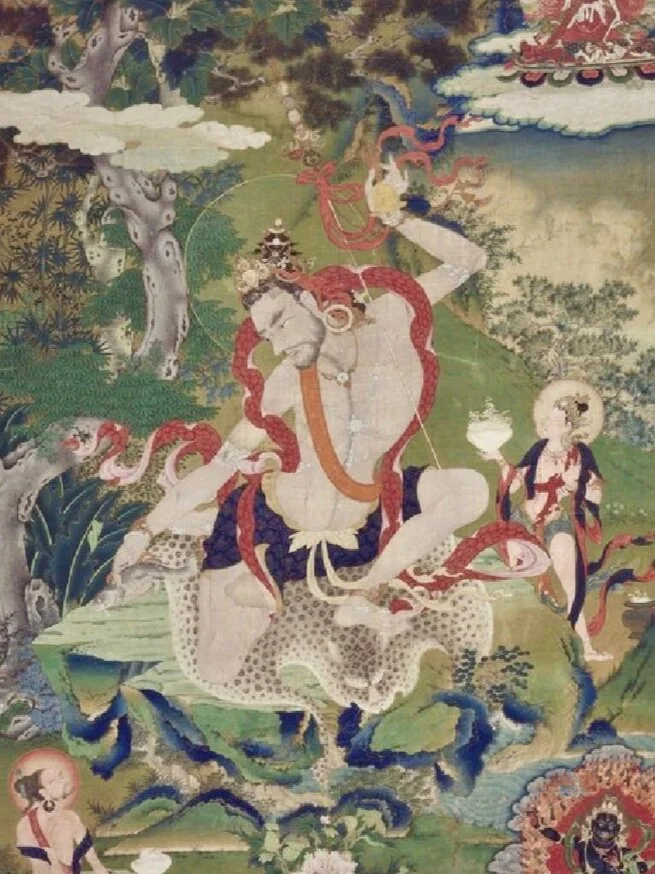Karma Kagyu Lineage Masters
Lineage is a line of spiritual masters through whom the sacred teachings and practices of the dharma are passed. This transmission, which takes place in a successive and unbroken way from teacher to disciple, ensures that the teachings and practices remain accurate, genuine, and alive through the passage of time.
The Kagyu school originated from the unconventional yogic traditions of the eighty-four Indian Mahasiddhas or “Greatly Realized Ones.” The teachings in this lineage were passed from one master to another individually, each one weaving their own understanding of the practices as they pass the teachings on as a live stream of blessing.
TILOPA (988-1069)
The human founder of the Kagyu school, Tilopa, was born into the priestly caste but adopted a monastic life. In the tradition of the great siddhas, Tilopa meditated unceasingly in the deep jungles of India. Through tantric mastery, he met the Buddha in his primordial form as Vajradhara (Dorje Chang). In addition to insight and mahamudra, he learned and passed on the yogic methods to his primary disciple, Naropa. The Kagyu lineage was born in this way.
NAROPA (1016-1100)
Naropa, a native of India as well, was born into a Brahmin family and studied at the Buddhist University at Nalanda, but abandoned his studies and position to search for the teacher Tilopa. After studying with Tilopa and overcoming a series of hardships to clear obstacles on the path, he was able to attain enlightenment. A great practitioner, Naropa is best known for his own unique expression of wisdom, consolidating the completion stage teachings into what are known as the Six Yogas of Naropa.
MARPA (1012-1096)
Naropa then transmitted the lineage to Marpa, who was born in southern Tibet to an affluent family. He first traveled to Nepal, where he studied with 2 famous students of Naropa, and then traveled to India and studied 12 years with Naropa and other great Indian siddhas. During his third visit to India, Naropa gave Marpa the full transmission of the lineage and declared Marpa to be his successor. After returning to Tibet, Marpa spent many years translating Buddhist scriptures and made major a contribution to the transmission of the complete buddhadharma to Tibet. Thus he is often known as Marpa, the translator.
MILAREPA (1052 - 1135)
Milarepa's life-story is famous in Tibetan culture, retold many times in villages and families as a source of inspiration and example -- as meaningful to the lay person as it was to the scholar. Milarepa is venerated by all Tibetan Buddhist schools, exemplifying renunciation, dedication and mastery.
Milarepa was born in western Tibet to a prosperous family in the late 11th century. When his father died, his family was deprived of their wealth by his aunt and uncle. At his mother's request, Milarepa left home and studied sorcery in order to take revenge, which resulted in the killing of many people.
When he realized the karmic consequences of his deeds, he was filled with remorse and a longing to find a teacher in order to practice the “true teaching.” This led him to seek to study with Marpa. But, before Marpa would teach Milarepa, he had him undergo many trials, such as letting him build and then demolish three towers in turn. Eventually, Marpa began to teach him, explaining that the trials were a means to purify Milarepa's negative karma.
Marpa then sent Milarepa to practice solitary meditation in caves and mountain retreats, which, after many years, resulted in "a deep experiential realization about the true nature of reality." Eventually, he attained enlightenment and lived as a fully realized siddha, fulfilling his destiny to teach many other disciples. He is best known for sharing his teachings through his acclaimed spiritual poetry known of as The Hundred Thousand Songs of Milarepa.
The spiritual groundwork he laid for those who came after him illustrates some of the fundamental aspects of the Vajrayana and Mahayana traditions.
The fulfillment of a seeker’s higher aspirations is not so much dependent on accumulating knowledge as on overcoming mental obstacles and gaining insight into the truth in oneself. For this, the guidance of an experienced teacher is a practical necessity. The role of the teacher… is even more important because it is only after the initiatory empowerment and elucidating instructions and guidance have been given that the disciple can settle him/herself in the work. (The Life of Milarepa, L.P. Lhalungpa, p.xiii, 1979)
All images courtesy of Himalayan Art Resources
Explore the Shangpa Kagyu Lineage in this recording series: Jewels of the Shangpa Kagyu Lineage
Learn about the originators and masters of the Shangpa Kagyu lineage in this six part recording series led by Lama Döndrup.





